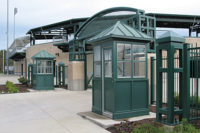Security & SDM Campus News April 2011






More Colleges Strengthen Access with Card, PIN, Biometrics Combos
To provide a safe, secure campus, the University of Georgia uses hand biometrics to verify students entering residence halls and athletic facilities and to limit dining hall access to students who paid for a meal plan. The technology plays a significant role, according to Bill McGee, manager, Bulldog Bucks office, Blackboard Transaction System, UGA card services.
In the Bulldog’s food service area, students either swipe their card or input their student number and then lay their hands on the reader. At the Ramsey Center, the number of people using the recreation center is high because Bulldog students, their relatives, faculty, staff and alumni can all use the facility. There are outdoor style hand readers for outer doors while standard hand readers inside the building control entry at the turnstiles.
“Housing basically has an electrified door system,” reports McGee. “Any door can be opened from the control desk or remote desks around campus. We also have cameras on the doors. By adding the hand reader, we go from an access control system to a security access system. We feel that this is an important attribute.” Users are “very impressed when we explain to them the big difference there is between a swipe card transaction and the combination swipe card with biometric transaction,” McGee says.
To Hold Down Campus Costs, Standalone Electronic Locks a Choice
When the University of Chicago was searching for an alternative to the traditional lock and key system, Barry Johnson, the university’s manager of information services for residence halls, says the aim was a secure solution that was cost effective, simple to install and easy to maintain.
“Keying is always a problem in a residence hall because of all the master keys for each of the various doors,” Johnson explains. “Within a portion of a building you may have three levels of master keys. Often, those keys are lost and have to be replaced. Then you worry about the lost key falling into the wrong hands and creating a security problem.”
With their ability to track and limit access, electronic card reader locks were the logical choice. The locks are standalone devices that require no hardwiring. “We looked at standalone and hardwired systems,” Johnson notes. “We found the cost of a hardwired system to be prohibitive because of all the infrastructure work. Like everything else, there are also maintenance costs associated with a hardwired system, so I don’t think there is a balance in their favor.” Beyond that, “the ability to issue a replacement card without reprogramming the lock was the number one reason why we chose standalone devices,” he says.
“We were able to use our existing ID cards as key cards, using track three for the locks and leaving tracks one and two for other functions,” referring to the card’s capabilities.
The University of Chicago faced one type of infrastructure challenge; other campuses may have more Ethernet-based wiring already existing. So there are solutions that employ Power over Ethernet (PoE) hardware, which connects to a facility’s Ethernet network with standard cabling, and provides full online access control even when the network is unavailable.
Open Campus, More Visitors: Better Visitor Management Called For
At some college and university campuses, especially those in urban areas, visitors may seem at times to outnumber students and faculty.
Take Loyola University with diverse facilities in an upper north side neighborhood, in busy downtown Chicago as well as elsewhere. During Loyola’s search for a “one-card” student ID system, a particular problem was posed by the fact that Loyola is an urban campus with other institutions nearby, and many facilities such as libraries frequently visited by students from places such as DePaul and Northwestern University.
“How to manage our libraries was the concern that drove our initial interest in visitor management,” says Frank Dale, Loyola’s manager of physical security. “We had a fair number of visitors as well as students from other campuses and needed a program for them – the ‘one-card’ system wouldn’t work. We were having some petty thefts plus, more importantly, we simply wanted to know who was in our facilities.”
Obviously, a “by hand” system wasn’t feasible and would not be able to scale as the campus expanded in various locations. Representatives of the libraries, the Dean of Students and student organizations helped find a better way to manage visitors through use of EasyLobby. And visitor management “has grown significantly since the initial library implementation,” points out Dale. The technology is at three libraries, seven residence halls and four administrative buildings. All systems network to a central database, where enterprise-wide data is integrated, analyzed and reported on.
There can be 1,500 visitors overall often handled every day. And, according to Dale, the typical Loyola residence hall receives approximately 100 visitors per day. The system is used for reconciliation at the end of visiting hours so that campus administration knows which guests are still on campus and those whom have checked out. In addition, there has been a noticeable reduction in theft in the libraries.
Tech Solutions Aim at the Danger of Floating Master Keys
Still have keys? There are ways to better manage them, eliminate the potential security vulnerabilities inherent in those masters and hook key control cabinets into the IT network.
Matt Smith, access control manager at Ohio University in Athens, has installed a key management solution that allows for the key storage cabinets to be on the school’s IT network for ease of management, efficiency and security. Before, university maintenance and custodial employees carried several different master keys in order to complete their assigned tasks. It was often a challenge for management to ensure that the keys were not transferred to others, misplaced or simply not returned if an employee left his or her position. With the installation of the system, management gained control of who could remove keys, what keys they could remove and for how long. Now, all master keys used by facilities are maintained in the KeyBank and removed as needed by authorized personnel.
Adds Smith, “With keys secured in the tamper-proof cabinet when not in use, we have lessened our exposure to the potential security risk of multiple high level or master keys for our facilities being carried on personal key rings.” The automated key control system has also made it easier to audit who accessed keys and when.
Student Networking Demands Can Empower College Security Approaches
As tech savvy kids take over college campuses, equipped with their smartphones, laptops and demanding high speed Internet requirements, the shift brings with it disadvantages – ranging from stolen expensive personal gear to Facebook threats – but also advantages for security operations ever more dependent on computer and communications technologies.
Bruce Harman, director of public safety for New Jersey City University in Jersey City, has taken the gigabits by the horns. He works in a fully wired campus with a high-performance fiber gigabit Cisco Ethernet network, boasting high-speed Internet access, a GothicAir 802.11 wireless net and remote net access using the university’s virtual private network.
So it is no wonder that in building his security video system, as one example, Harman loves the iPad application that’s part of his video management system. With a next-step goal of about 150 cameras, he is – similar to colleagues – migrating from analog to digital and sees “a role for megapixel cameras in high risk areas. Prices are coming down.” In addition, the security cameras do more than security. “We can see vehicle flows and parking queuing at the gates” and take action. “We also can establish and adjust virtual tours” as a force multiplier, he adds.
Looking for a reprint of this article?
From high-res PDFs to custom plaques, order your copy today!










